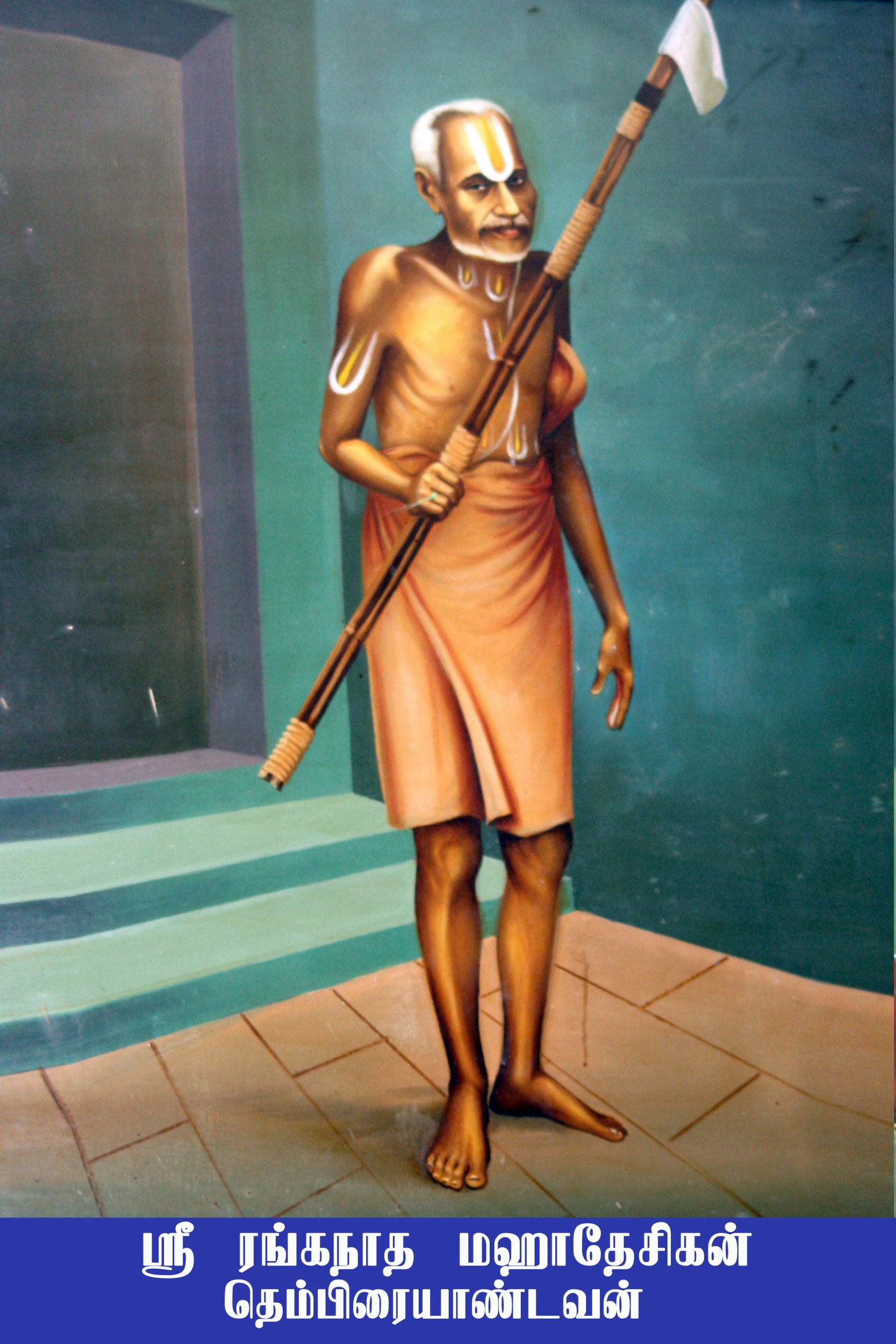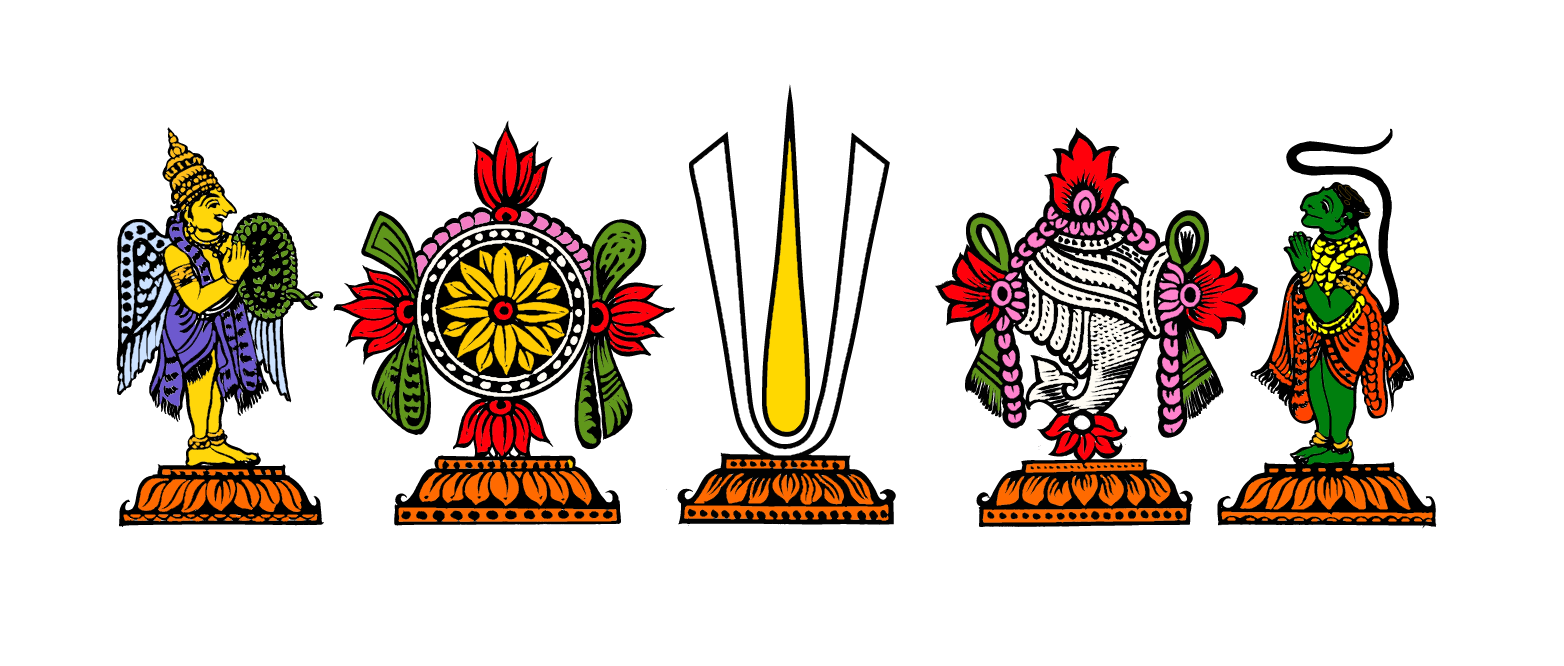
Our Previous Acharyas
Srimad Thenbirai Andavan Sri Ranganatha Mahadesikan
Birth Star: Avani Revati
śrīmad veda-vatamsa-lakṣmaṇa-munehe prāptāgamānta-dvayaṁ
tena śrī-raghu-puñga-vāñghri yugaḷe nyastātma-rakśābharaṁ
śrīmad śrīnidhi-yogi-varya karuṇā-labdhābja chakrāñgaṇaṁ
vande śānti-virakti-purnaṁ-anaghaṁ śrī-rañganāthaṁ-guruṁ
“I prostrate at the lotus feet of the blemishless guru Srimad Ranganatha Mahadesikan (Thenbirai Andavan) who possesses complete saintly qualities such as peacefulness and detachment; who studied ubhaya-vedanta-kalakshepams (personal tutelage of the sacred texts of the dual-Vedanta) under the divine lotus feet of Srimad Nammandavan Sri Vedanta Ramanuja Mahadesikan; whose atma-rakshabharam (ritual surrender) was ordained at the divine lotus feet of Lord Raghunatha, the presiding Deity of Vaduvoor by Srimad Nammandavan Sri Vedanta Ramanuja Mahadesikan; and who was initiated into the renunciate order of sannyasa by the incessant grace and compassionate glance of Srimad Akkur Andavan Sri Srinivasa Mahadesikan.”

Srimad Thenbiran Andavan Sri Ranganatha Mahadesikan was born in Thenbirai village on the banks of the river Pamani to Sri U. Ve Vangeepuram Seshadriyachar on 19th August 1886 in the sashti-samvatsara year of Vijaya in the Tamil month of Avani under the birth-star of Revati. He was given the name Venkataraghavan at birth.
Several famous astrologers who looked at the horoscope of Srimad Venkataraghavachar Swami had predicted that he would become a sannyasi and a parama-viraktha (a renunciate of the highest order).
After undergoing the Srimad Venkataraghavachar Swam learned the Sama Veda, and became an expert exponent of the text.
Subsequently, he mastered Sanskrit, kavya-shastra (poetry-writing) and Veda-shakhas (the branches of the four Vedas) at Thirukkudanthai Sanskrit College. He also went to Rajamannar Kovil and mastered vyakarana-shastra (Sanskrit grammar and rhetoric) under the tutelage of Sri. U. Ve. Rangachar Swami (who later became the 39th Jeer of Sri Ahobila Mutt as Sri Parankusha Shatakopa Yathindra Mahadesikan). Later he went to Vilakkudi to learn tarka-shastras (debate and logic) under the eminent guidance of Tarkika Simham Sri. U. Ve. Srinivasachariar Swami. After mastering all these, he further learned and mastered mimamsa under the guidance of Maha Mahopadhyaya Brahmasri Kuppu Swami Sastrigal and Brahmasri Chinna Swami Sastrigal.
Srimad Nammandavan performed pancha-samskaram (five-fold ritual initiation into Sri Vaishnavism) for Srimad Venkataraghavachar Swami when he was quite young. Later, he conducted his bhara-samarpanam (ritual surrender) at the lotus feet of the presiding Deity of Vaduvur, Sri Rama.
In the year 1908, Srimad Venkataraghavachar Swami was married to Srimati Vijayavalli Ammal. Immediately after his marriage, Srimad Venkataraghavachar Swami was awarded the holy Vaishwadeva-upadesham (a daily sacrificial ritual) from his paternal uncle, Maha Vidwan Brahma Nidhi Sri. U. Ve. Ramabhadrachar Swami. During his grihasthahrama (householder life), Srimad Venkataraghavachar Swami observed pancha-kala-anushtanam in an austere and rigorous manner (this refers to the five daily duties of a Sri Vaishnava: abhigamanam or the daily visit to the temple; upadhanam or the gathering of paraphernalia for the daily worship; ijya or the ritual worship of the family Deity; svadhyaya or the study of sacred scriptures; and yoga or meditation on the form, names and auspicious qualities of the Lord).
Later, Srimad Venkataraghavachar Swami served as a religious teacher in a national high school. During this time he became an examiner for Sanskrit competitions conducted by Sri Kanchi Kamakoti Matam. The presiding pontiff of the Matam, Sri Sankaracharya had utmost respect for Srimad Venkataraghavachar Swami’s pandityam (scholarliness).
Srimad Venkataraghavachar Swami’s deep sense of renouncement from the material world and his acceptance of severe austerity can be observed by the fact that he lived under the strict vow of unccha-vrutthi (surviving only on voluntary alms) in the footsteps of Srimad Vedanta Desikan.
He undertook grantha-chathushtya-kalakshepams (personal tutelage of the four main esoteric texts of Sri Vaishnavism) under Srimad Nammandavan, where he used to listen to the acharya’s divine words with rapt attention and full concentration.
In 1922, two renowned scholars, Sri. U.Ve. Vidwan Ramaswami Iyengar and Sri. U.Ve. Krishnamachariar arranged an upanyasam (a series of discourses) on the Ramanaya by Srimad Venkataraghavachar Swami. Thousands of devotees attended the series of upanyasams which lasted over two months.
Even after speaking at such upanyasams and vidvat-sadas (assembly of scholars), when Srimad Venkataraghavachar Swami was offered a sambhavanai (a monetary honorarium), he would refuse to accept it. Such was his sense of detachment and simplicity. Srimad Venkataraghavachar Swami was full of such sattva-gunas from a young age. Simplicity, honesty, purity, veracity, courage, equality, renunciation, lucidity and a profound knowledge of the sampradaya were hallmarks of his divine personality.
One could see simplicity in the clothes he wore, the food he ate and the lifestyle he led. He was a down-to-earth person who won the respect of many of his admirers. He exhibited unparalleled virakti (detachment) by showing no desire to save money for his family. His deep detachment and voluntary austerity were attributed to his profound knowledge of our the Sri Vaishnava siddhanta of prapatti (total surrender to the Lord) and his maha-vishvasam (unshakeable faith) in the doctrine.
However, Srimad Nammandavan departed to adorn thirunadu quite unexpectedly in Kanchipuram in the year 1931. Srimad Akkur Andavan succeeded Srimad Nammandavan to adorn the acharya-pitam. Srimad Venkataraghavachar Swami continued his kalakshepams under the new pontiff.
Srimad Akkur Andavan was immensely pleased with Srimad Venkataraghavachar Swami’s divine qualities such as jnanam, vairagyam and anushtanam. By the order of the Lord, Srimad Akkur Andavan felt that Srimad Venkataraghavachar Swami was the right person to succeed him to the acharya-pitam of Srimad Andavan Ashramam. Accordingly, he awarded the preksha-mantram (a pre-condition to enter the renunciate sannyasa order) and prapatti-praypga to Srimad Venkataraghavachar Swami.
In 1946, Srimad Venkataraghavachar Swami’s dharma-patni (wife) departed to attain acharyan-thiruvadi. Srimad Akkur Andavan’s health had also started to deteriorate due to old age. After deep contemplation, Srimad Venkataraghavachar Swami went to Srimad Akkur Andavan and sought his blessings to enter the renunciate order of sannyasa.
Extremely pleased with Srimad Venkataraghavachar Swami’s decision, Srimad Akkur Andavan immediately made arrangements for the ashrama-svikaram (acceptance of the sannyasa order) ceremony of Srimad Venkataraghavachar Swami.
On the 21st day of the Tamil month of Aippasi in the sashti-samvatsara year of Vaya, corresponding to 6th October 1946, Srimad Akkur Andavan awarded the holy order of sannyasa to Sri. U. Ve. Brahma Nidhi Thenbirai Venkataraghavachariar Swami, in the presence of thousands of disciples. He was given the title ‘Sri Ranganatha Mahadesikan’ and was fondly called Srimad Thenbirai Andavan.
Five months later, on 19th March 1947 (krishna-paksha dvadashi tithi of the Tamil month of Panguni in the sashti-samvatsara year of Vaya), Srimad Akkur Andavan departed to adorn thirunadu.
Even after accepting sannyasa and adorning the acharya-pitam, Srimad Thenbirai Andavan’s lifestyle did not change. This was because he was already practicing the renunciation, rigorous discipline and detachment of a sannyasi much earlier, having completely renounced worldly comforts.
Every morning, Srimad Thenbirai Andavan would deliver kalakshepams on Sri Bhashya, Gita Bhashya and Bhagavad-vishayam after the morning rituals of aradhana and paduka-tirtham. In the evenings, he would render kalakshepams on divya-suktis such as Srimad Ramayana, Nyaya Siddhanjanam and Adhikarana Saravali. He initiated thousands of disciples by awarding samashrayanam and bharanyasam. Srimad Andavan would consume only one meal a day, and that too of very little quantity once in the morning.
Three people served as Srikaryam (the main administrative head of the Ashramam) during the time of Srimad Thenbirai Andavan: Sri. U. Ve. Chakravarthi Krishnamacharya Swami, Sri. U. Ve. V.K. Srinivasachariar Swami and later Sri. U. Ve. Srinivasa Raghavachariar Swami (also known as Kannan Swami – later Srimath Thirukkudanthai Andavan).
Under the divine order of Srimad Thenbirai Andavan, a monthly magazine called ‘Sri Ranganatha Paduka’ was started in October 1955. It is still being published every month, with a view to connect the Ashramam with the disciples.
Srimath Thenbirai Andavan’s health deteriorated in the early 1960s due to rigurous anusthanams, meagre intake of food, and issues caused by breathing problems. At that time, Srimad Andavan awarded the preksha-mantram and mokshashrama-ahnika-anushthanam to three scholars of the Ashramam: U. Ve. Sri. Kannan Swami, U. Ve. Sri. Mysore Gopalacharya Swami (who later became Srimad Mysore Andavan) and Mannargudi Ganapadi Vidvan U. Ve. Sri. Narasimhacharya Swami. He requested them to be ready to take up the renunciate order of sannyasa at any time when called.
In April 1963, Srimad Andavan’s health continued to deteriorate further. On April 4th 1963, Srimad Andavan’s condition became critical, and most of the sishyas assembled at the premises of Periashramam. After Srikaryam Sri. U. Ve. Kannan Swami arrived, arrangements were made for his ashrama-svikaram ceremony, where he would accept the renunciate order of sannyasa.
Early morning on April 5th 1963 (coinciding with shukla-dvadashi tithi under the star of magha), in the presence of thousands of sishyas and abhimanis (disciples and well-wishers), Srimad Thenbirai Andavan ordained the ascetic order to Sri U. Ve. Kannan Swami. The new acharya was named Srimad Vedanta Ramanuja Mahadesikan. Within a few hours on the same day, Srimad Thenbirai Andavan departed to adorn thirunadu, completely satisfied after having found his worthy successor.

